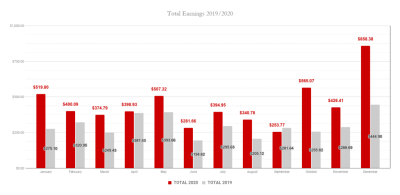Thinking about turning your photography hobby into a side hustle? Selling your photos on Shutterstock might just be the perfect way to do it! Shutterstock is one of the biggest stock photo platforms out there, connecting photographers with millions of buyers worldwide. Whether you’re a seasoned pro or just starting out, it offers a straightforward way to earn money by sharing your images. But how much can you really make? That depends on a few factors like the quality of your photos, your contribution level, and how often your images get downloaded. Let’s dive into what you need to know to get started and what kind of earnings you can expect.
Understanding Shutterstock’s Payment Structure for Contributors

Shutterstock’s payment system can seem a bit complex at first, but once you understand it, it’s pretty straightforward. Essentially, your earnings depend on your contributor level, the type of license purchased, and the number of downloads your images receive. Here’s a quick breakdown:
| Contributor Level | Download Volume | Royalty Rate |
|---|---|---|
| New Contributor | 0 – 50 downloads/month | 15-30% |
| Level 2 | 51 – 250 downloads/month | 30% |
| Level 3 | 251 – 500 downloads/month | 35% |
| Level 4 | 501+ downloads/month | 40% |
Your contributor level increases as you upload more images and generate more downloads, which in turn can boost your earnings per sale. The more popular your images are, the higher your royalty rate can become.
When someone downloads your photo, you earn a percentage of the sale based on the license type:
- Standard License: Suitable for most uses like websites, blogs, and social media.
- Enhanced License: For larger prints, merchandise, or products that generate higher revenue.
For each license type, Shutterstock pays a fixed royalty percentage, which varies depending on your contributor level. For example, at higher levels, you might earn up to 40% of the sale price. The actual amount you make per download can range from just a few cents to several dollars, depending on the license and the price set by Shutterstock.
Additionally, Shutterstock offers monthly and yearly bonuses for top contributors, and if your photos become especially popular, you might even qualify for exclusive incentives. Overall, your earning potential is pretty flexible—it’s all about your upload volume, image quality, and how much demand there is for your photos. So, if you’re serious about making money from your photography, understanding this payment structure is a key step on your journey to turning clicks into cash!
Factors That Influence Your Earnings from Selling Photos
When it comes to earning money from selling photos on Shutterstock, it’s not just about snapping a great shot and uploading it. Several key factors come into play that can significantly influence how much you can earn. Let’s break down these elements so you can get a clearer picture of what impacts your income.
Quality and Uniqueness of Your Photos
First and foremost, the quality of your images matters a lot. High-resolution, well-composed, and properly lit photos tend to perform better. Shutterstock’s buyers are looking for images that are sharp, clear, and visually appealing. Additionally, unique and original photos that stand out in a crowded marketplace can fetch higher sales. Stock photos that offer a fresh perspective or cover niche topics might attract more buyers.
Keywording and Metadata
Proper keywording is crucial. Think of keywords as the search terms that help buyers find your photos. The more accurately and comprehensively you tag your images, the higher the chances they’ll be discovered. Using relevant keywords, including synonyms and related terms, can significantly boost your visibility and sales.
Market Demand and Trends
Market trends can heavily influence your earnings. For example, if a certain theme like remote work, sustainability, or specific holidays is trending, photos related to these topics tend to sell more. Staying updated with current trends and creating images that match market demand can increase your earning potential.
Image Size and Resolution
Higher resolution images generally fetch higher prices and are more appealing to buyers who need print-ready visuals. Uploading images in the maximum quality allowed ensures you don’t miss out on potential sales, especially from clients who require large or high-quality prints.
Contributor Level and Licensing
Shutterstock has different contributor levels, and as your portfolio grows and you gain more sales, you can unlock higher earning rates. Also, the type of license purchased—standard or enhanced—affects your earnings. Enhanced licenses typically pay more, as they allow buyers to use images in more extensive ways.
Number of Uploads and Consistency
The more quality images you upload regularly, the better your chances of making sales. Consistency helps keep your portfolio active and visible, attracting repeat buyers and increasing overall earnings over time.
Tips to Maximize Your Income on Shutterstock
If you’re serious about making the most money from your photos on Shutterstock, there are some smart strategies you can adopt. Let’s go over some practical tips to help you maximize your income and stand out as a contributor.
Focus on Niche Topics
While it might be tempting to shoot anything and everything, focusing on niche topics can really pay off. Think about specialized themes like medical photography, food styling, or specific industries such as tech or travel. Niche images often face less competition and can command higher prices.
Maintain a Consistent Upload Schedule
Uploading regularly keeps your portfolio fresh and active. Shutterstock’s algorithm favors contributors who consistently add new content. Set a manageable goal—say, uploading a few images each week—and stick to it. Over time, this consistency can lead to more exposure and sales.
Optimize Your Keywords and Titles
Take the time to craft detailed and accurate titles, descriptions, and keywords for each image. Use a mix of broad and specific terms to improve discoverability. Remember, the more precise your metadata, the better your images will rank in search results.
Study Best Sellers and Trends
Spend some time browsing Shutterstock’s top-selling images and trending categories. Notice what themes, styles, and subjects are popular. Use this insight to guide your shooting and uploading strategy, creating images that match current demand.
Invest in Quality Equipment and Editing
High-quality gear and good editing skills can elevate your images. Use a decent camera and editing software to ensure your photos are sharp, color-accurate, and visually appealing. Well-edited images tend to attract more buyers and can lead to higher earnings.
Leverage Social Media and Marketing
Don’t rely solely on Shutterstock’s platform. Promote your portfolio on social media, photography forums, or personal websites. Building a personal brand can attract more clients and potential buyers, increasing your sales and income.
Keep Learning and Improving
Stock photography is a competitive field, so continuous learning is key. Take online courses, watch tutorials, and seek feedback from fellow photographers. Improving your skills and staying updated with industry trends will help you produce better images and earn more over time.
By understanding what influences your earnings and applying these tips, you’ll be well on your way to turning your passion for photography into a profitable venture on Shutterstock. Remember, patience and persistence are your best friends in this journey!
Common Challenges and How to Overcome Them
Jumping into the world of selling photos on Shutterstock can be exciting, but it’s not without its hurdles. Knowing what challenges you might face and how to tackle them can make your journey smoother and more rewarding.
One of the biggest challenges is standing out in a crowded marketplace. With millions of images available, it can feel overwhelming to get noticed. To overcome this, focus on creating high-quality, unique, and niche-specific photos. Research current trends and see where your skills fit best. Use relevant keywords and detailed descriptions to improve your images’ visibility in search results.
Another common issue is copyright concerns. Many new contributors worry about their work being stolen or misused. To protect yourself, always add appropriate metadata, watermarks during your initial editing, and consider adding a small watermark or signature if allowed. Remember, Shutterstock has strict policies on copyright, so make sure your images are original or properly licensed.
Technical challenges also pop up, like understanding what makes a photo acceptable for sale. Shutterstock has specific requirements regarding image quality, resolution, and content guidelines. Familiarize yourself with their standards—shoot in high resolution, ensure proper lighting, and avoid over-editing. Use editing software to enhance your images without making them look unnatural.
Dealing with rejection is another hurdle. Not every photo will be accepted, and that’s okay! Use rejection as a learning opportunity. Check Shutterstock’s feedback or guidelines to understand why an image was rejected. Improve your skills by studying successful contributors’ portfolios and continuously practicing your craft.
Finally, managing your expectations about income can be tricky. Earnings vary widely based on factors like image quality, niche demand, and marketing efforts. Be patient, keep uploading consistently, and diversify your portfolio. Over time, this persistence can lead to a steady stream of income.
Conclusion: Is Selling Photos on Shutterstock a Profitable Venture?
So, is selling photos on Shutterstock a profitable venture? The answer depends on several factors—your skill level, niche selection, consistency, and how much effort you put into optimizing your portfolio. For many photographers and hobbyists, it can be a great way to earn passive income while doing what they love.
While some contributors make a significant income, for most, it’s more of a supplemental revenue stream rather than a full-time paycheck. Earnings can range from a few dollars per month for casual uploaders to hundreds or even thousands for those with a large, high-quality portfolio catering to high-demand niches.
Remember, success on Shutterstock isn’t just about uploading a handful of images. It’s about building a diverse, high-quality collection, understanding market trends, and continuously improving your photography skills. Over time, as your portfolio grows and your images become more popular, your earnings can increase considerably.
In summary, selling photos on Shutterstock can be profitable if you approach it strategically. It’s a fantastic platform for photographers to share their work, gain exposure, and generate income—especially if you’re passionate about photography and willing to invest the time to learn and adapt. So, if you’re ready to turn your passion into profit, Shutterstock might just be the right place to start!


